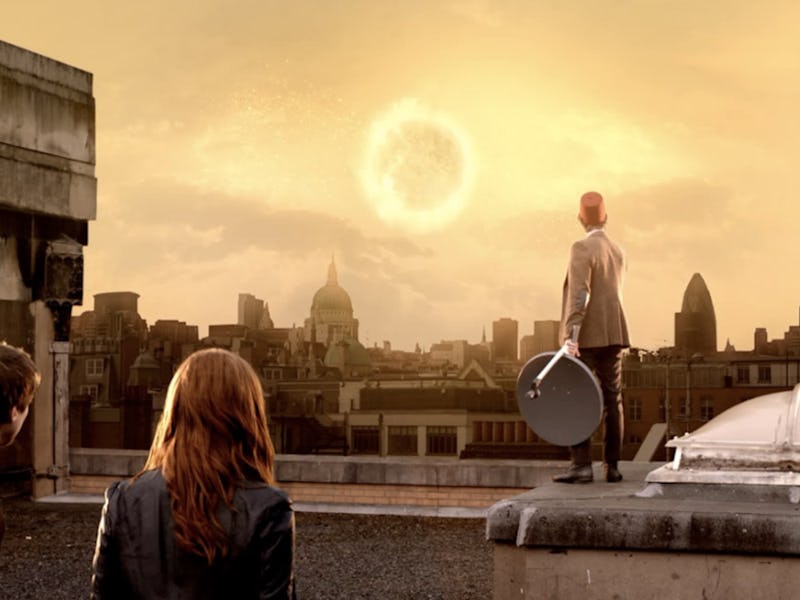15 Years Ago, Doctor Who Dropped Its Most Perfect Finale
Why "The Big Bang" has never been topped.

Why does the Last of the Time Lords have to face a universe-destroying conundrum at the end of every year? When Doctor Who relaunched in 2005, the tradition of massive season finales, complete with massive armies of foes (often Daleks) and stakes bigger than several galaxies, became commonplace. With “The Parting of the Ways” in 2005, Russell T Davies set a near-impossible standard for how Doctor Who could deliver an epic finale that also felt personal and real. Fans of the first RTD era will tell you he certainly came close with “Doomsday” and “Journey’s End,” but truly, the Doctor Who story that represents the true Platonic ideal for what a Who finale could and should be is the 2010 banger, “The Big Bang.”
Yes, it took the ending of Steven Moffat’s first season as Who showrunner to remix and refine the RTD finale formula of the 9th and 10th Doctor era. And with “The Big Bang” — which first aired on June 26, 2010 — Moffat achieved that by delivering a story that didn’t try to go bigger than previous finales at all. Instead, “The Big Bang” suggests the end of the world could happen in the cramped recesses of a museum, and maybe, on the rooftop.
The Doctor (Matt Smith) in the Pandorica.
In the previous episode, “The Pandorica Opens,” the 11th Doctor (Matt Smith), discovers that a fabled prison called the Pandorica was, in fact, a trap created to imprison him, because he has been branded the most dangerous creature in all of creation. This notion, that all the Doctor's enemies would unite to project the galaxy from him is drawn from themes in the 10th Doctor (David Tennant) era, in which we saw that Doctor pushing his powers to the limits of both practically and morality. The Daleks, Cybermen, and various other baddies have a unique reason to trap the 11th Doctor in the Pandorica, but you could have also drawn a straight line from 2009’s “The Waters of Mars” and had a similar justification. RTD went wild with the idea that the Doctor is like a living weapon, but the Moffat era was when we had to start living with that notion a bit more.
And yet, despite every star going out at the end of “The Pandorica Opens” and a simulacrum of Rory (Arthur Darvill) seemingly shooting Amy (Karen Gillian), the tone of “The Big Bang” is refreshingly upbeat. Young Amy (Caitlin Blackwood), who never met the Doctor, now lives in a world in which there are no stars, and the Earth is the only thing that still exists in the heavens. Moffat weaves this retroactive bizarro world with deft touches, hinting at real-world issues of how pseudo-science can become mainstream, and real science can feel like ancient history. This is Moffat at his timey-wimeiest, not only is the history of Earth retroactively rewritten, but the Doctor escapes from the Pandorica with a non-linear time travel solution. How did the Doctor give himself his sonic screwdriver? He gave it to Rory in the future so he could have it in the past. As the 12th Doctor (Peter Capaldi) would say a few years later: “This is called the bootstrap paradox. Google it.”
Moffat’s reliance on paradoxical storytelling logic may be his greatest contribution not only to Doctor Who, but also to mainstream science fiction. While prose time travel narratives have often employed this kind of effect-before-cause, it’s really hard to point to a mainstream sci-fi phenomenon that is so brazen about paradoxes as the Moffat era of Doctor Who. Even the phrase “timey wimey” came from a Moffat episode in the RTD era, the immortal classic, “Blink.” And, with “The Big Bang” the timey wimey paradoxes are a feature, not a bug.
Refreshingly, Moffat doesn’t treat the time-travel tricks as the central premise, the way he did in “Blink.” Instead, all the shenanigans are there to allow “The Big Bang” to tell a much smaller, more intimate story about Amy, Rory, River Song, and the Doctor. Most of the action of this epic finale, in which the Doctor has to reset the entire universe, takes place in a museum. Yes, there’s a sense of a wild battle being waged across all of time, one which ties together the entire season. But the stakes are firmly with how the characters feel about their fates.
Amy and Rory’s wedding was the true ending of “The Big Bang.”
All season, there’s been tension about Rory and Amy’s relationship and what role the Doctor plays in it. Here, Rory’s devotion as the immortal Roman, guarding Amy through the centuries, reveals a grounded parallel figure to the Doctor. Someone long-lived, existing in history and the present day, but very much grounded. Moffat may love cheap and nasty time travel, but he also loves sending characters the long way around. Smith is on fire in this episode as the Doctor, waving his hands around, dropping one-liners, and alternating between humor and deadly seriousness.
But it's Darvill and Gillian who really sell all of it. Because, ultimately, this is an episode that ends in a wedding, a wedding that the Doctor pulled Amy away from at the beginning of the season. It’s a classic, sweet, and unapologetically sentimental button to an over-the-top episode that feels much shorter than it actually is. Unlike some aspects of the RTD era, “The Big Bang” seemed to suggest that Amy and Rory were even more important to the DNA of Doctor Who than we could have possibly imagined at the start of the season.
“The Big Bang” was the dawning of a new golden era of Who, one full of big feelings and small, realistic human problems. After this point, the series would try to end the universe in countless other ways, but never so convincingly as this moment, and perhaps, never as fun, either.